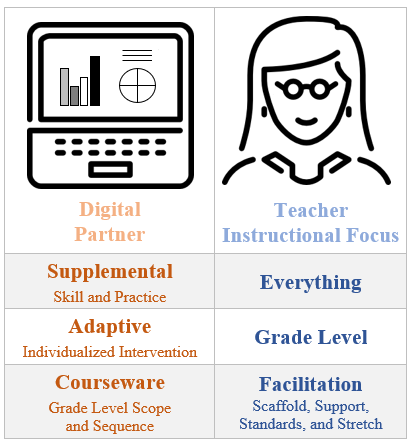It’s that time of year again, when students are excited to meet their new teachers and staff are busy preparing classrooms. It’s important to kick the school year off on the right foot. One that can lead to excitement, innovation, and higher student gains. As the saying goes, “We can’t keep doing the same thing, and expect different results.”
It’s time to consider partnering with digital content. When teachers utilize digital curriculum, it is like having an aide in the classroom – one for each and every student. In the CIA of blended learning model, teachers partner with digital curriculum to help deliver Depth of Knowledge one and two (DoK 1-2). This frees time in the day for the teacher to work differently. They no longer have to provide all content. Classroom teachers need to partner with the digital curriculum and allow it to do what it is best at – creating an individualized learning space for each student. Again, the technology is good only at a low level of understanding, DoK 1-2.
Releasing control to another is a big ask, I know. Think about other partnerships you have in your life. Take your spouse or kids for instance. They may not put the dishes in the dishwasher the way you would, but it gets done. They may not fold the clothes the way you might, but again it gets done. Teachers may find that the digital curriculum does not instruct the way they would have, but it will get done. And just like you may walk behind your spouse or kids and rearrange the dishes, or re-fold the clothes, the classroom teacher supports the digital curriculum with guided instruction, helping students to master essential standards.
Teachers should release some (not all) control to the digital partner and change to a more guided instructional approach. Yes, they will still need to reach down to DoK 1-2, targeting specific students and topics. They also have more time to take students to a deeper Depth of Knowledge (e.g. DoK 1-3). When students have two venues to obtain instruction, there is less opportunity for achievement gaps to develop. As teachers use the data from their digital partner, they can remediate and extend learning at the individual and group level, as needed.
Like all the people you have dated in your life, each brought something different to the partnership. The same is true with digital curriculum. The type of digital curriculum used changes the way teachers must interact with it. Skill and practice software is fine for a station rotation center. Yet, this leaves the teacher having to serve up intervention and grade level content to all students. With an adaptive software, that meets each learner at their individual level, the teacher can focus on ensuring that students are exposed to grade level standards. Digital courseware, like that found at the secondary level, targets grade level standards. In this situation the teacher would facilitate the learning by providing scaffolds, support where students stumble and have misconceptions, target essential or power standards, and extend the learning to higher order thinking.
It’s a new school year. Time to reflect and start fresh. Set some goals. What digital curriculum might you like to date (test out)? Look for a digital partner you can share instruction with in your classroom. Make a new year resolution to distribute the load and change your instructional approach to a blended personalized classroom. Partner with a quality digital curriculum.


